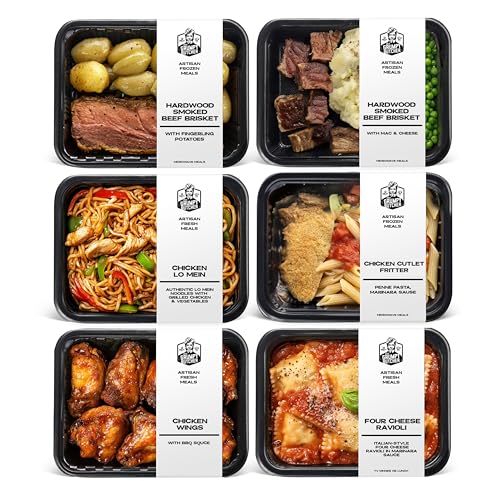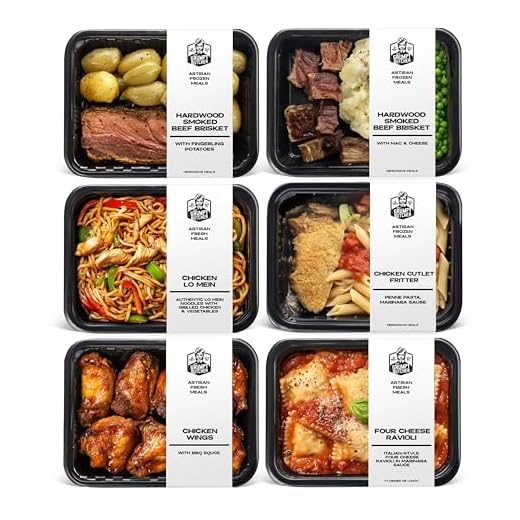
When it comes to the longevity of pre-cooked meals, it’s crucial to delve into the intricacies of their storage characteristics. These well-curated dishes, carefully arranged and meticulously prepared, provide a convenient solution in our fast-paced world. However, it’s essential to know how long they stay fresh in storage, ensuring we can relish these delectable options while maintaining optimal safety and taste.
Exploring the lifespan of these convenient ready-to-eat platters unveils a fascinating blend of culinary expertise and scientific understanding. Factors such as temperature, packaging techniques, and specific ingredients play pivotal roles in determining the longevity of these meals. As we delve deeper into this captivating topic, we embrace the opportunity to unravel the secrets behind preserving the quality and flavor of these culinary delights.
Understanding the science behind how these pre-prepared dishes endure in cold storage requires an exploration of bacteria growth, oxidation, and moisture levels. By identifying the intricate balance between freshness and decay, we unlock the key to prolonging the shelf life of these meals. Join us as we embark on a journey through the interplay of flavors, nutrition, and sustenance, unveiling the secrets of preserving the essence of convenience in every bite.
Exploring Shelf Life: The Duration of Factor Meals in Refrigeration
Understanding the longevity of pre-prepared meals in the refrigerator is essential for maintaining food safety and quality. In this section, we will delve into the factors that influence the shelf life of these ready-to-eat meals and provide valuable insights into maximizing their freshness and flavor.
1. Storage Conditions and Temperature
The way you store factor meals and the temperature at which they are kept significantly impact their shelf life. Proper storage conditions, such as maintaining a consistent temperature and ensuring adequate air circulation, play a crucial role in preserving the quality and safety of the meals.
2. Ingredients and Food Packaging
The ingredients used in factor meals, along with the quality of their packaging, contribute to their overall shelf life. Different ingredients have varying levels of perishability, and understanding their characteristics can help determine how long the meals can sustain freshness. Additionally, the packaging materials and techniques employed by manufacturers can impact the meals’ ability to retain their taste and texture.
By examining these key factors, we can gain a better understanding of the shelf life of factor meals and make more informed decisions about storing and consuming them. It is crucial to remember that while these guidelines provide useful insights, proper food safety practices and regular visual inspections should always be followed to ensure optimal freshness and minimize the risk of foodborne illnesses.
Understanding the Influencing Factors of Meal Longevity
When it comes to preserving food items and ensuring their freshness, several variables come into play. The longevity of meals stored in refrigerators can depend on various factors that impact their overall quality and taste. By understanding these influencing factors, individuals can make informed decisions about their meal planning and storage practices.
One crucial factor that affects the longevity of meals is the temperature of the refrigerator. The colder the temperature, the slower the rate of bacterial growth and enzymatic activity. It is recommended to set the refrigerator temperature to around 40°F (4°C) to maintain the freshness and quality of the stored meals.
Another essential factor is the type of packaging used for storing meals. Proper packaging prevents the exposure of meals to air, moisture, and odors, thus extending their shelf life. Vacuum-sealed containers, airtight bags, and sealed plastic containers are effective options for preserving the quality of meals in the refrigerator.
The composition and ingredients of the meals themselves also play a significant role in determining their longevity. Some ingredients, such as leafy greens and herbs, are more delicate and prone to spoilage. Therefore, it is advisable to store meals containing these ingredients separately or consider adding them immediately before consumption to maintain their freshness.
Frequent opening and closing of the refrigerator door can also impact the longevity of stored meals. Every time the fridge door is opened, warm air enters, causing fluctuations in temperature and potentially compromising the quality of the stored meals. To minimize these temperature changes, it is recommended to plan and retrieve all necessary items at once and avoid unnecessary opening of the refrigerator door.
- Temperature: Maintain a refrigerator temperature at around 40°F (4°C) to slow bacterial growth and enzymatic activity.
- Packaging: Use vacuum-sealed containers, airtight bags, or sealed plastic containers to prevent exposure to air, moisture, and odors.
- Composition: Store meals containing delicate ingredients separately or add them just before consumption.
- Refrigerator door: Minimize the opening and closing of the refrigerator door to avoid temperature fluctuations.
By considering these influencing factors and following proper meal storage practices, individuals can ensure that their refrigerated meals remain fresh, flavorful, and safe for extended periods.
Effective Techniques for Properly Storing Factor Meals to Prolong Freshness
When it comes to ensuring the longevity of your prepared meals, employing suitable storage techniques is crucial. By implementing these methods, you can extend the shelf life and preserve the quality and taste of your factor meals for an extended duration.
1. Optimal Storage Temperature
To maintain the freshness of your factor meals, it is essential to store them at an appropriate temperature. Consider refrigerating your meals at a consistent temperature between 34°F (1°C) and 40°F (4°C). This temperature range prevents bacterial growth and slows down the deterioration process, allowing your meals to stay fresh for a longer period.
2. Proper Container Selection
Choosing the right containers for storing your factor meals can significantly impact their longevity. Opt for airtight containers or sealable plastic bags to minimize exposure to air and moisture, which can lead to spoilage. Make sure the containers are clean, dry, and specifically designed for food storage to ensure optimal preservation.
| Storage Tips | Benefit |
|---|---|
| Avoid overcrowding | Prevents condensation buildup |
| Label containers with date | Enables easy tracking of freshness |
| Store in the coldest part of the fridge | Minimizes temperature fluctuations |
| Avoid storing near strong-smelling foods | Prevents flavor transfer |
By following these storage techniques, you can efficiently extend the lifespan of your factor meals in the most convenient and cost-effective way. Properly stored meals not only retain their nutritional value but also ensure that you can enjoy them at your convenience without compromising on taste or quality.
Ensuring Food Safety: Tips for Monitoring and Discarding Expired Meals from Factor
It is essential to prioritize food safety by properly monitoring and discarding expired meals to prevent potential health risks. To maintain freshness and quality, it is vital to be aware of certain indicators that indicate when it is time to dispose of meals from Factor.
1. Pay attention to expiration dates: Regularly check the expiration dates on the meals to ensure that you consume them before they spoil. Expired meals may lose their taste, texture, and nutritional value, posing potential health risks due to bacteria growth.
2. Consider signs of spoilage: Apart from expiration dates, be observant of any signs that suggest the meal has gone bad. Mold growth, off odors, and changes in color or texture are indications of spoilage. Discard meals that exhibit these signs, as consuming them could lead to foodborne illnesses.
3. Practice proper storage techniques: Maintain proper storage conditions to prolong the shelf life of your Factor meals. Store them in the refrigerator at temperatures below 40°F (4°C) to inhibit bacterial growth, ensuring maximum freshness and safety.
4. Trust your senses: Utilize your senses of sight, smell, and taste to assess the quality of your meals. If something appears or smells off, or if the taste seems unusual, it is best not to consume it.
5. Adopt a “first in, first out” approach: When restocking your fridge with new Factor meals, place them behind the older ones to ensure that you consume the oldest meals first. This practice helps minimize the chance of forgetting about older meals and inadvertently consuming them past their expiration.
6. Dispose of meals responsibly: In case you have meals that have exceeded their expiration dates or show signs of spoilage, dispose of them properly. Seal them in a bag to prevent odor contamination and place them in the designated trash bin. Avoid consuming expired meals, as they may cause food poisoning or adverse health effects.
By closely monitoring and promptly discarding expired meals, you can maintain food safety and preserve the freshness and quality of your Factor meals. Prioritize your well-being by adhering to these tips and enjoying your meals while they are at their peak.
Strategies for Planning Your Meals and Incorporating Pre-made Dishes into Your Routine
When it comes to establishing a well-structured and efficient meal planning routine, one important aspect to consider is incorporating pre-made dishes into your meals. By strategically integrating premade dishes into your routine, you can save time and effort while still ensuring a nutritious and satisfying meal. In this section, we will explore various strategies and tips for incorporating factor meals into your meal planning routine.







